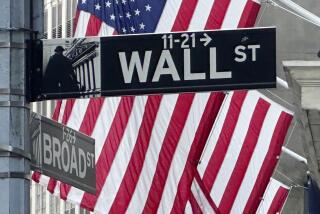Bond Yields’ Rise Might Not Be Over
- Share via
Federal Reserve policymakers meet today, and they’re widely expected to announce that they have adopted a credit-tightening “bias”--meaning that they are more likely to raise short-term interest rates in the near future than cut them.
The Fed meeting follows Friday’s shocking report on April consumer price inflation, which showed prices up 0.7%, far more than expected.
But was that report a one-month fluke? Many analysts think so. They doubt that U.S. companies suddenly are enjoying terrific pricing power in this highly competitive economy.
Even so, many also believe that the Fed is looking for an excuse to take back some or all of the cuts made last fall, when the central bank reduced its target for the federal funds rate--the overnight loan rate among banks--from 5.5% to the current 4.75%.
Those cuts were made amid the global market turmoil that followed Russia’s currency devaluation. But the U.S. economy barely blinked at that turmoil. Now, the Fed is likely to be more concerned that its official rates are too low given the economy’s ongoing strength.
The bond market, meanwhile, has already made adjustments: Yields have soared as much as 1.5 percentage points on some Treasury securities since last fall.
Does the bond market already have a Fed rate hike or two priced into yields? In other words, have bonds already accounted for any future rate hike?
Many economists watch the 2-year Treasury note yield’s relationship to the federal funds rate. At 5.29% as of Monday, the 2-year T-note yield is about a half-point above the fed funds rate.
Tad Rivelle, who manages bond portfolios at Metropolitan West Asset Management in Los Angeles, notes that the 2-year T-note yield historically hovers between 0.25 and 0.40 point above the fed funds rate, on average. When the Fed is in credit-tightening mode, the difference between the fed funds rate and the 2-year T-note yield tends to widen.
So today’s market yields may at best have one quarter-point Fed increase built in, and possibly none at all.
Which simply means that if you believe the Fed will decide to actually raise its official rates in the months ahead, bond yields are probably going higher as well.
(BEGIN TEXT OF INFOBOX / INFOGRAPHIC)
Is Enough, Enough Already?
Yields on Treasury securities have surged this year and are as much as 1.5 percentage points above their lows last fall, as bond traders worry about rising inflation and the potential for a credit-tightening move by the Federal Reserve. Some experts say the rate rise has been an overreaction. Yields on five Treasury issues, current figures compared with their 1998 lows:
3-month Treasury bill
1998 low: 3.62%
Monday: 4.67%
*
2-year Treasury note
1998 low: 3.82%
Monday: 5.29%
*
5-year Treasury note
1998 low: 3.97%
Monday: 5.51%
*
10-year Treasury note
1998 low: 4.16%
Monday: 5.64%
*
30-year Treasury bond
1998 low: 4.72%
Monday: 5.89%
Source: Bloomberg News
More to Read
Inside the business of entertainment
The Wide Shot brings you news, analysis and insights on everything from streaming wars to production — and what it all means for the future.
You may occasionally receive promotional content from the Los Angeles Times.










